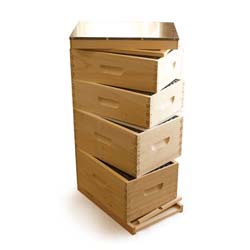Once you have removed the wax cappings from your frames to process raw honey, you can use a few different things to strain the honey for wax and debris.
If you are using an extractor, place a mesh strainer over the bucket the honey will flow into. You can do the same thing without an extractor by crushing and straining the honeycomb over a bucket with a mesh strainer. You can also use cheesecloth, a fine sieve, or any filter with a tight enough weave to let honey flow through while trapping bits of wax. It is important to always have some container to catch the honey with – you do not want your precious honey flowing all over the floor!
If your honey has wax or debris in it after straining it, find something with a smaller mesh grade to filter it through again. You want a fine mesh to strain with – something thin enough to block out most chunks of wax/debris while also allowing the honey to flow through it.
What to Do With Wax Cappings After Honey Extraction
Once you’ve finished extracting your honey, you’ll be left with a pile of wax cappings. Don’t throw them away – these cappings contain a lot of valuable wax that can be cleaned, rendered, and reused for countless purposes. Here’s how to process them.
Step 1: Let the Bees Clean Them Up
Just like you might return extracted frames to your bees for cleanup, you can do the same with wax cappings. Place them out for your bees, and they’ll happily remove the bulk of the remaining honey. This makes the next steps easier.
Step 2: Rinse the Cappings
After the bees have done their part, it’s time to wash away the rest of the honey. Place the cappings in a large container, like a five-gallon bucket, and rinse them with cold water. Use your hand to stir and mix them around, helping to loosen any sticky residue.
Pour the mixture through a fine mesh sieve to strain out the water and excess honey. You’ll likely need to repeat this 2–5 times, each time using fresh cold water, until the rinse water runs fairly clear.
Step 3: Dry the Wax Cappings
You can dry the cappings before rendering or melt them with some water. If you do dry them first, it does take some time.
Step 4: Render and Filter the Wax
If you’re drying the cappings first, melt the wax cappings down slowly. Pour the melted wax through a fine mesh sieve to strain out debris. Depending on how clean you want the final product, you may need to repeat the melting and filtering process a few times, moving to a finer mesh each round. It also works to melt the cappings in water. When you pour the water/wax mixture into containers, the water and debris separate naturally.
Step 5: Store or Use the Wax
When your wax is as clean as you’d like, pour it into molds for storage. These wax blocks can be saved for future use or melted again when you’re ready to make candles, lip balms, wood polish, or any other beeswax products.
Wet vs. Dry Cappings
You’ll notice that not all cappings look the same.
- Dry Cappings: Bees cap the honey with a thin layer of wax that has an air pocket between the honey and the wax. These usually appear lighter in color.
- Wet Cappings: Bees cap the honey directly against the surface of the liquid with no air space. These often look darker since the wax is in direct contact with the honey.
Both types of cappings can be cleaned and processed the same way—the difference is simply in appearance.
